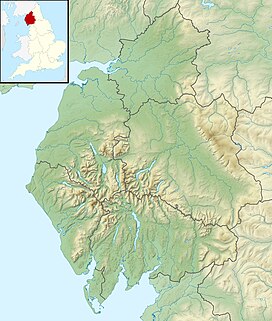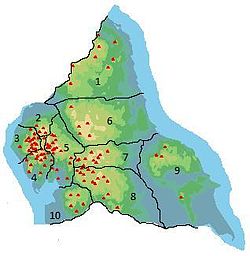| This article needs additional citations for verification. Please help improve this article by adding citations to reliable sources. Unsourced material may be challenged and removed. Find sources: "Cross Fell" – news · newspapers · books · scholar · JSTOR (January 2011) (Learn how and when to remove this message) |
| Cross Fell | |
|---|---|
 Cross Fell seen from the Eden Valley Cross Fell seen from the Eden Valley | |
| Highest point | |
| Elevation | 893 m (2,930 ft) |
| Prominence | 651 m (2,136 ft) |
| Parent peak | Helvellyn |
| Listing | Hewitt, Marilyn, Nuttall, Hardy |
| Coordinates | 54°42′10″N 2°29′14″W / 54.70278°N 2.48722°W / 54.70278; -2.48722 |
| Geography | |
  | |
| Location | North Pennines, England |
| OS grid | NY687343 |
| Topo map | OS Landranger 91 |
Cross Fell is the highest mountain in the Pennines of Northern England and the highest point in England outside the Lake District. It is located in the North Pennines Area of Outstanding Natural Beauty. It lies within the county of Cumbria and the historic county boundaries of Cumberland.
The summit, at 893 metres (2,930 ft), is a stony plateau, part of a 7+3⁄4-mile-long (12.5-kilometre) ridge running north-west to south-east, which also incorporates Little Dun Fell at 842 metres (2,762 ft) and Great Dun Fell at 848 metres (2,782 ft). The three adjoining fells form an escarpment that rises steeply above the Eden Valley on its south-western side and drops off more gently on its north-eastern side towards the South Tyne and Tees Valleys.
Cross Fell summit is crowned by a cross-shaped dry-stone shelter. On a clear day there are excellent views from the summit across the Eden Valley to the mountains of the Lake District. On the northern side of Cross Fell there are also fine views across the Solway Firth to the Southern Uplands of Scotland.
The fell is prone to dense hill fog and fierce winds. A shrieking noise induced by the Helm Wind is a characteristic of the locality. It can be an inhospitable place for much of the year. In ancient times it was known as "Fiends Fell" and believed to be the haunt of evil spirits. St Augustine of Canterbury is said to have blessed the hill when he arrived here on his travels so it became known as Cross Fell in the Christian tradition, although it has been speculated that the fell became known as Cross Fell ("cross" meaning "angry") because of the evil spirits.
Local geography

The upper parts of Cross Fell and the adjoining fells are formed mainly from beds of mudstone, sandstone and siltstone of the Yoredale Group whilst lower ground is formed by multiple layers of the Carboniferous Limestone. Where erosion-resistant beds surface, there are steep rock faces. There are also strata of shale and gritstone that surface on the fell. On the south and west facing slopes of Cross Fell the rock faces have been broken up by frost action to give a scree slope made up of large boulders. The local terrain shows obvious evidence of recent glaciation and is covered by thin soil and acidic peat.
Cross Fell, Great Dun Fell and Little Dun Fell form a block of high terrain which is all over 800 metres (2,625 ft) in elevation. This is the largest block of high ground in England and tends to retain snow-cover longer than neighbouring areas. Snow can be found in gullies on the north side of Cross Fell as late as May in most years. In some years, lying snow has been known to persist until July and fresh snowfall in June (mid-summer in the Northern Hemisphere) is common.
Precipitation on Cross Fell averages around 2,800 millimetres (110 in) per year. Local flora includes a number of rare alpine plants such as the Starry Saxifrage and a mountain Forget-me-not. Cross Fell is covered by what is known as "siliceous alpine and boreal grassland". It is the southernmost outlier of this vegetation type, which is common to highlands in Scotland and Scandinavia. It is a designated Special Area of Conservation (SAC). Local farmers are required to keep free-roaming sheep off the tops of the fells in order to avoid damaging the natural flora.
Cross Fell is a conspicuous feature in the landscape. It dominates the skyline on almost the entire 20-mile (32-kilometre) length of the A66 trunk road between Penrith and Stainmore. It can also be seen from many points in the Lake District, including the Helvellyn summit, and from high ground throughout Dumfriesshire and Northumberland. Most remarkably, it is claimed that it is visible in exceptional circumstances from the summit of Carnedd Llewelyn in Snowdonia (Wales) at a distance of 123 miles (198 kilometres).
Notes
- The Helm Wind can be very strong where it is channelled down gullies in the side of the escarpment. It is experienced particularly in the villages of Milburn and Kirkland.
References
- Historic shelter restored to celebrate iconic trail’s anniversary
- "The Helm Wind Dufton Village Cumbria". www.dufton.org.uk. Archived from the original on 27 September 2007.
- North Pennines AONB Partnership article on Cross Fell Archived February 21, 2006, at the Wayback Machine
- "GeoIndex Onshore". British Geological Survey. Retrieved 20 October 2022.
- Cumbrian Wildlife: plants Archived April 30, 2006, at the Wayback Machine
- "SAC selection - 6150 Siliceous alpine and boreal grasslands". www.jncc.gov.uk. Joint Nature Conservation Committee. Moor House – Upper Teesdale. Archived from the original on 16 March 2006. Retrieved 10 July 2006.
- "Viewfinder panoramas (Carnedd Llewelyn)". viewfinderpanoramas.org. de Ferranti, Jonathan. Retrieved 14 June 2020.
External links
- Panoramas
- Jonathan de Ferranti. "Cross Fell, North Pennines". www.viewfinderpanoramas.org.
| Hills of the North Pennines | |
|---|---|
| Marilyns | |
| Hewitts | |
| Other hills | |
| Most prominent mountains of Britain and Ireland (the P600s) | ||
|---|---|---|
| Northern Highlands (20) |    | |
| Western Highlands (20) | ||
| Central and Eastern Highlands (13) | ||
| Southern Highlands (15) | ||
| Islands (13) | ||
| Scottish Lowlands, England and Wales (13) | ||
| Republic of Ireland, Northern Ireland (25) | ||
| Marilyns of Northern England | ||
|---|---|---|
| 1. Northumberland |  | |
| 2. Northern Lakeland | ||
| 3. Western Lakeland | ||
| 4. Central and Southern Lakeland | ||
| 5. Eastern Lakeland | ||
| 6. North Pennines and Durham | ||
| 7. Northern Yorkshire Dales | ||
| 8. Southern Yorkshire Dales | ||
| 9. North York Moors to the Humber | ||
| 10. Forest of Bowland | ||